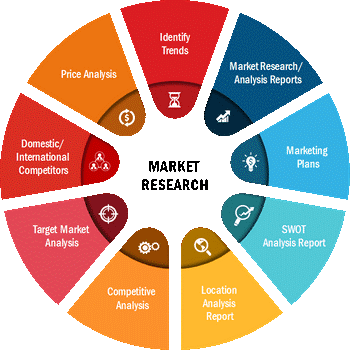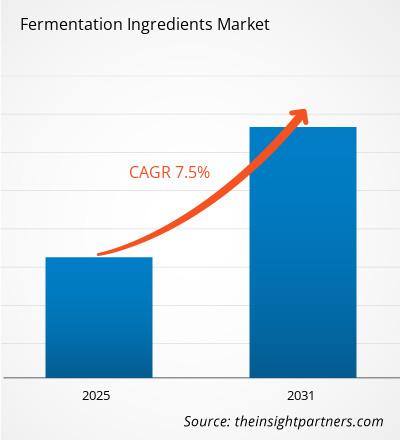2021年发酵原料市场规模达280亿美元,预计将超过10亿美元到2031年将达到540亿;预计 2022 年至 2031 年复合年增长率为 7.5%。
发酵原料用于食品和工业等行业。饮料、药品、动物饲料和个人护理产品。氨基酸、有机酸、维生素、酶以及发酵培养物的其他产品和副产品改变了最终产品的质地、味道和颜色。用牛奶生产奶酪是发酵原料最常见的应用之一,也有助于延长产品的保质期。
市场动态
人们对发酵成分的健康益处的认识不断提高,以及肥胖和消化问题的日益普遍,正在推动发酵成分市场的增长。这些成分为食品和饮料制造商提供了保存食品的便捷解决方案。此外,它们很容易获得。个人护理和化妆品行业对发酵成分的需求也在显着增长。
市场范围
“ 《2031 年全球发酵原料市场分析》是一份专门针对深入研究,特别注重市场趋势分析。该报告旨在提供发酵原料市场的概况以及详细的市场细分。它根据领先市场参与者的表现提供关键市场统计数据,并突出显示市场的主要趋势和机会。
战略见解
市场细分
发酵原料市场根据类型和应用进行细分。根据类型,市场进一步细分为酵母、氨基酸、有机酸、维生素、酶等。从应用来看,发酵原料市场分为食品和发酵原料。饮料、药品、动物饲料、个人护理等。
< strong>
报告提供了详细的行业概述,包括定性和定量信息。它提供了基于各个细分市场的全球发酵原料市场的概述和预测。它还提供了 2021 年至 2031 年 5 个主要地区的市场规模和预测估计:北美、欧洲、亚太地区 (APAC)、中东和中东地区。非洲 (MEA) 和南美洲。每个地区的发酵原料市场都细分为各自的国家。该报告涵盖了全球18个国家的分析和预测,以及各地区当前的趋势和机遇。
北美在 2021 年发酵原料市场占据主导地位。该地区的主导地位主要是由主要国家奶酪、酸奶和酒精的高消费推动的。此外,个人护理和化妆品行业对发酵成分的需求增加也促进了该地区的市场增长。
下图展示了发酵原料市场的收入增长趋势:
< span style="font-size: 10pt; font-family: verdana, Geneva, sans-serif;">来源:Insight Partners 分析
报告从需求端和供给端分析了影响发酵原料市场的因素。此外,它还评估影响市场进展的市场动态,即驱动因素、限制因素、机会和未来趋势。该报告还提供了详尽的波特五力市场分析。
COVID-19 大流行的影响
期间COVID-19大流行期间,尽管发酵原料供应中断,导致全球范围内出现短缺,但发酵原料的需求相对稳定。短缺主要是由于供应链的干扰以及对发酵原料中使用的不同成分的禁令造成的。旅行和贸易禁令还导致原材料短缺,影响了这些产品的生产和分销,导致价格上涨。发酵成分主要用于各种应用,包括食品和饮料。饮料、药品、化妆品和个人护理品。由于严格的封锁和制造工厂的关闭,大流行阻碍了这些行业的增长,从而阻碍了发酵原料市场的增长。然而,自 2021 年以来,由于原材料的供应以及食品和饮料、个人护理等最终用途行业的需求不断增长,发酵原料的产量激增。
市场参与者
报告强调了发酵原料市场的关键有机和无机增长策略。市场参与者采用的有机增长策略包括产品发布、产品批准以及专利和活动。此外,市场上出现的无机增长策略包括收购、伙伴关系和合作。这些活动为市场参与者扩大业务和客户群铺平了道路。
发酵原料市场报告介绍了该市场主要公司的概况,重点介绍了他们的 SWOT 分析和市场策略。公司简介部分重点关注领先的行业参与者,提供诸如提供的组件和服务、过去 3 年的财务信息以及过去 5 年的主要发展等信息。从事发酵原料市场的几家公司名单如下:
- Döhler GmbH
- DSM
- Chr.汉森控股 A/S
- 拉勒曼公司
- 凯里集团有限公司
- 嘉吉公司
- 英国联合食品有限公司
- Lonza
- 阿什兰
- 安琪酵母有限公司
The Insight Partner 的专业研究和分析团队由经验丰富的专业人士组成,具有先进的统计专业知识。该团队还在现有研究中提供各种定制选项。
- Historical Analysis (2 Years), Base Year, Forecast (7 Years) with CAGR
- PEST and SWOT Analysis
- Market Size Value / Volume - Global, Regional, Country
- Industry and Competitive Landscape
- Excel Dataset

Report Coverage
Revenue forecast, Company Analysis, Industry landscape, Growth factors, and Trends

Segment Covered
This text is related
to segments covered.

Regional Scope
North America, Europe, Asia Pacific, Middle East & Africa, South & Central America

Country Scope
This text is related
to country scope.
Trends and growth analysis reports related to Food and Beverages : READ MORE..
The List of Companies
1. E.I. Dupont De Nemours and Company
2. Ajinomoto Corporation Inc.
3. Koninklijke DSM N.V.
4. CHR. Hansen A/S
5. BASF SE
6. Lallemand Inc.
7. Angelyeast Co., Ltd.
8. Döhler Group
9. Cargill, Incorporated
10. Lonza
The Insight Partners performs research in 4 major stages: Data Collection & Secondary Research, Primary Research, Data Analysis and Data Triangulation & Final Review.
- Data Collection and Secondary Research:
As a market research and consulting firm operating from a decade, we have published and advised several client across the globe. First step for any study will start with an assessment of currently available data and insights from existing reports. Further, historical and current market information is collected from Investor Presentations, Annual Reports, SEC Filings, etc., and other information related to company’s performance and market positioning are gathered from Paid Databases (Factiva, Hoovers, and Reuters) and various other publications available in public domain.
Several associations trade associates, technical forums, institutes, societies and organization are accessed to gain technical as well as market related insights through their publications such as research papers, blogs and press releases related to the studies are referred to get cues about the market. Further, white papers, journals, magazines, and other news articles published in last 3 years are scrutinized and analyzed to understand the current market trends.
- Primary Research:
The primarily interview analysis comprise of data obtained from industry participants interview and answers to survey questions gathered by in-house primary team.
For primary research, interviews are conducted with industry experts/CEOs/Marketing Managers/VPs/Subject Matter Experts from both demand and supply side to get a 360-degree view of the market. The primary team conducts several interviews based on the complexity of the markets to understand the various market trends and dynamics which makes research more credible and precise.
A typical research interview fulfils the following functions:
- Provides first-hand information on the market size, market trends, growth trends, competitive landscape, and outlook
- Validates and strengthens in-house secondary research findings
- Develops the analysis team’s expertise and market understanding
Primary research involves email interactions and telephone interviews for each market, category, segment, and sub-segment across geographies. The participants who typically take part in such a process include, but are not limited to:
- Industry participants: VPs, business development managers, market intelligence managers and national sales managers
- Outside experts: Valuation experts, research analysts and key opinion leaders specializing in the electronics and semiconductor industry.
Below is the breakup of our primary respondents by company, designation, and region:

Once we receive the confirmation from primary research sources or primary respondents, we finalize the base year market estimation and forecast the data as per the macroeconomic and microeconomic factors assessed during data collection.
- Data Analysis:
Once data is validated through both secondary as well as primary respondents, we finalize the market estimations by hypothesis formulation and factor analysis at regional and country level.
- Macro-Economic Factor Analysis:
We analyse macroeconomic indicators such the gross domestic product (GDP), increase in the demand for goods and services across industries, technological advancement, regional economic growth, governmental policies, the influence of COVID-19, PEST analysis, and other aspects. This analysis aids in setting benchmarks for various nations/regions and approximating market splits. Additionally, the general trend of the aforementioned components aid in determining the market's development possibilities.
- Country Level Data:
Various factors that are especially aligned to the country are taken into account to determine the market size for a certain area and country, including the presence of vendors, such as headquarters and offices, the country's GDP, demand patterns, and industry growth. To comprehend the market dynamics for the nation, a number of growth variables, inhibitors, application areas, and current market trends are researched. The aforementioned elements aid in determining the country's overall market's growth potential.
- Company Profile:
The “Table of Contents” is formulated by listing and analyzing more than 25 - 30 companies operating in the market ecosystem across geographies. However, we profile only 10 companies as a standard practice in our syndicate reports. These 10 companies comprise leading, emerging, and regional players. Nonetheless, our analysis is not restricted to the 10 listed companies, we also analyze other companies present in the market to develop a holistic view and understand the prevailing trends. The “Company Profiles” section in the report covers key facts, business description, products & services, financial information, SWOT analysis, and key developments. The financial information presented is extracted from the annual reports and official documents of the publicly listed companies. Upon collecting the information for the sections of respective companies, we verify them via various primary sources and then compile the data in respective company profiles. The company level information helps us in deriving the base number as well as in forecasting the market size.
- Developing Base Number:
Aggregation of sales statistics (2020-2022) and macro-economic factor, and other secondary and primary research insights are utilized to arrive at base number and related market shares for 2022. The data gaps are identified in this step and relevant market data is analyzed, collected from paid primary interviews or databases. On finalizing the base year market size, forecasts are developed on the basis of macro-economic, industry and market growth factors and company level analysis.
- Data Triangulation and Final Review:
The market findings and base year market size calculations are validated from supply as well as demand side. Demand side validations are based on macro-economic factor analysis and benchmarks for respective regions and countries. In case of supply side validations, revenues of major companies are estimated (in case not available) based on industry benchmark, approximate number of employees, product portfolio, and primary interviews revenues are gathered. Further revenue from target product/service segment is assessed to avoid overshooting of market statistics. In case of heavy deviations between supply and demand side values, all thes steps are repeated to achieve synchronization.
We follow an iterative model, wherein we share our research findings with Subject Matter Experts (SME’s) and Key Opinion Leaders (KOLs) until consensus view of the market is not formulated – this model negates any drastic deviation in the opinions of experts. Only validated and universally acceptable research findings are quoted in our reports.
We have important check points that we use to validate our research findings – which we call – data triangulation, where we validate the information, we generate from secondary sources with primary interviews and then we re-validate with our internal data bases and Subject matter experts. This comprehensive model enables us to deliver high quality, reliable data in shortest possible time.



 Get Free Sample For
Get Free Sample For